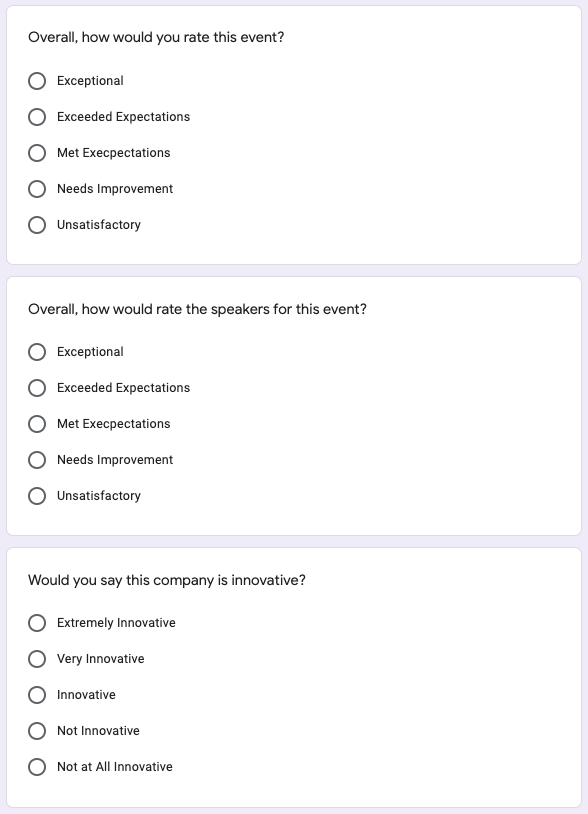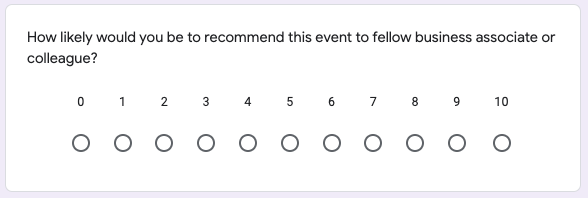Conducting Effective Surveys
Jul 23, 2020 • 6 Minute Read
Introduction
It is extremely important to survey your customers and understand what they are thinking so you continue to build products, services, and solutions they want to buy. But how do you conduct effective surveys? And how do you ensure that people will fill them out? You need both pieces in order to ensure that a survey is effective. You need people to fill it out and you need the answers to the questions to be helpful. One without the other doesn’t do much to help your business.
Length of the Survey
Surveys should be quick, easy to fill out, and focused on a specific event or product. A good format might be, for example, three to five required multiple choice questions with one optional question that is open ended. This way, people can give feedback if they want to without an obligation to write anything. These three to five questions should take just a few minutes to fill out and be simple for the customer.
Additionally, the survey should be focused on a specific event or product. Do not make the topic too broad or customers are not going to know how to respond and what the survey actually relates to. Be sure that the survey is focused on something that the customer recently interacted with, like an event or purchase, and make it specific.
When to Send the Survey
The last section discussed that the survey should be focused on a specific event or product. So, when do you send it? The answer is, as quickly as possible. It is important that the event or product/solution purchase is fresh in the customer’s mind so within days to a week is your best bet.
Usually Monday through Thursday gets the best response, as by Friday people are pretty checked out. I also recommend sending the survey from the platform itself (e.g. Survey Monkey) and then a follow up email two to three days after the initial survey with a link to the survey. This helps customers get a reminder, and a customer's eye might be drawn to one format over the other.
Survey Subject Line
Most surveys are sent via email because it is quick and efficient. Usually the open rate of these emails is about 10-20% when you are surveying people externally. This means that an even lower percentage of people are actually filling it out once they open it. However, if they don’t open it, they definitely won’t fill it out.
So how do you make the survey enticing so people open the email? Here are some tips:
-
Urgency helps the customer act quickly, hence increasing your open rate.
- Example: "Tell Us What You Think Today" lets people know that this needs to be done quickly .
-
Curiosity will make people want to open the email.
- Example: "How Was Last Wednesday?" if the event happened or a product arrived last Wednesday. A customer might open it because they are unsure what you are talking about.
-
Personalization: never send a survey or an email that looks like spam. Use the customer's name in the subject line to encourage them to open, and be sure to use their name in the body of the email as well.
-
Add value by sending something of value to the customer with the survey email.
- Example: "Solution Hacks are Here." Maybe you send the customer some special information about the solution they bought or a copy of the presentation from the event they attended along with the survey link.
You want to try to draw the customer in so they at least click "open," and you have a chance the survey is filled out.
Questions in the Survey
We have decided on the length, when to send it, and the subject line. These three elements will hopefully increase your chances that people will open the survey. So, once they open it and start to fill it out, what do you want to ask? You need to ask questions that can help you conduct research and continue to innovate products and solutions that your customers want.
Here is an example of a survey that would help you get the information you need. This particular survey example is focused on feedback for an event. For best results, you might want to make questions one through four required and question five optional.
Keep the first few questions pretty basic. These first three have a sliding scale with just five options.
The fourth question uses what is commonly referred to at the NPS, or Net Promoter Score, for the event. Unlike the other questions, an NPS score gives the survey participant eleven options from zero to ten. There is a set way to calculate NPS and it can be found [here] (https://www.netpromoter.com/know/). NPS is a methodology that allows you to look at Promoters (people who support your product) versus your Detractors, (people who could hinder your product's growth), and omit the Passives (people who are simply neutral). For example, if you have 60% Promoters, 30% Passives, and 10% Detractors, the NPS will be +50 which is 60 (promoter percentage) minus 10 (detractor percentage). The industry benchmark for a tech company is usually somewhere around +35.
Leaving an open ended question at the end like this one allows people to add any feedback needed, but do not make it required.
Conclusion
Surveys are very important to gain customer feedback. However, it is important that they are simple, short, and effectively executed so you can gather feedback.
Advance your tech skills today
Access courses on AI, cloud, data, security, and more—all led by industry experts.



